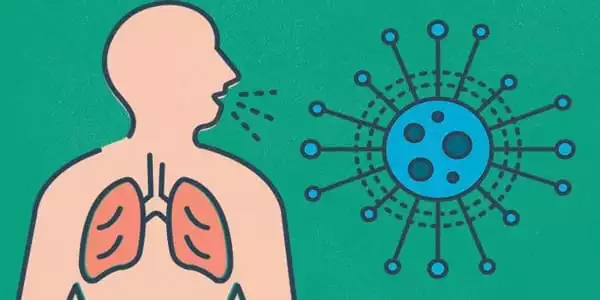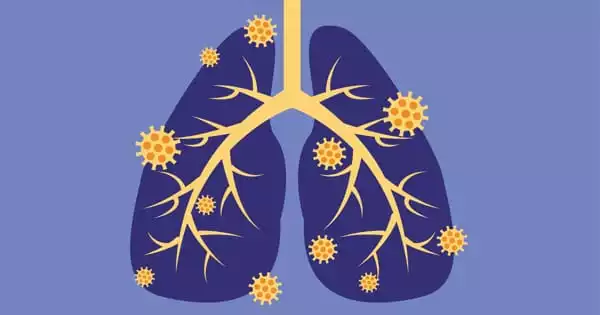Scientists have discovered a startling benefit for some asthmatics: they are less susceptible to COVID-19. Researchers report in the Proceedings of the National Academy of Sciences on April 19 that the same immune system proteins that cause excess mucus production and airway closure in persons with allergic asthma may also form a protective shield around susceptible airway cells. The discovery explains why persons with allergic asthma appear to be less sensitive to COVID-19 than others with associated lung diseases, and it could potentially lead to new coronavirus treatments.
Asthma is a breathing illness characterized by inflammation of the airways. As a result, coughing, wheezing, and shortness of breath occur. In the United States, approximately 8% of persons have asthma, with approximately 60% of them having allergic asthma. Allergens such as pollen or pet dander can cause allergic asthma symptoms. Exercise, weather, or breathing in irritants such as strong perfumes, cleaning smells, or air pollution can trigger other types of asthma.
When it comes to colds and flu, asthma is usually bad news. Most specialists predicted that coronavirus infections and asthma would be a lethal combination at the onset of the pandemic, according to Luke Bonser, a cell biologist at the University of California, San Francisco who was not involved in the study. That is also true for persons whose asthma is not induced by allergies, as well as those suffering from linked lung ailments such as chronic obstructive pulmonary disease, or COPD. People with these disorders are at a high risk of developing severe COVID-19.
However, as the epidemic proceeded, researchers discovered that persons with allergic asthma were not acquiring severe COVID-19 as frequently as expected. Here’s why that might be the case.
In the case of [allergic] asthma, the body makes an error. It’s mistaking a harmless thing, like pollen, for a worm. However, it was unclear how IL-13 protected persons with allergic asthma against SARS-CoV-2, the coronavirus that causes COVID-19.
Burton Dickey
Protein protection
A protein known as interleukin-13, or IL-13, distinguishes allergic asthma from other kinds of asthma and COPD. IL-13 normally aids the body in its battle against parasites such as worms. Certain T cells secrete the protein, and the body reacts by producing sticky mucus and restricting airways. This traps the worms, keeping them in place until additional immune system cells arrive to kill them.
“In the case of [allergic] asthma, the body makes an error. It’s mistaking a harmless thing, like pollen, for a worm,” Burton Dickey, a pulmonologist at M.D. Anderson Cancer Center in Houston who was not involved in the study, says.
However, it was unclear how IL-13 protected persons with allergic asthma against SARS-CoV-2, the coronavirus that causes COVID-19. To discover out, Camille Ehre of the University of North Carolina School of Medicine in Chapel Hill and colleagues cultured cells from the lining of six lung donors’ airways. To simulate allergic asthma, some of the cells were treated with IL-13. The scientists then infected some of the cells with SARS-CoV-2.
Lawn trouble
The next task was to compare how cells that had not been treated with IL-13 behaved while they were healthy and after they were infected with the coronavirus. The study confirmed that uninfected cells grew in lawns resembling lush grasslands, where the tufts of waving fronds are actually hairlike protrusions called cilia that arise from the tips of airway-lining cells. Cilia’s movements assist in moving mucus and anything caught in the mucus out of the lungs.
Coronavirus-infected cells appeared very different. The lush lawn had become covered in slime, and bald patches had emerged as sick cells perished. Doomed cells are forced out of the cilia lawn and inflate like a balloon. The inflation happens partly because chambers called vacuoles inside the infected cells get clogged with viruses. “It’s just filled with viruses, and then it gets kicked out of the club and it blows up and releases all these viruses,” Dickey says.
However, not all of the cells in the infected grass were equally damaged. When researchers examined the cells from the side, they discovered that cells with cilia were infected with the coronavirus. However, goblet cells, which produce mucus but lack cilia, were rarely infected. This could be because a protein called ACE2 coats the surface of ciliated cells considerably more frequently than goblet cells. The coronavirus enters cells through the protein ACE2.

A sticky solution
The outcomes were dramatically different when the cells were treated with IL-13 before being infected with the coronavirus. The lawn of waving cilia atop the treated cells remained substantially intact, with considerably fewer dying cell balloons rising above the surface. However, the fronds did not wave as strongly as they did in untreated cells. The researchers discovered that IL-13 inhibits cilia beating. Because cilia are less active, virus-laden mucus may linger longer. “Inside the lungs, that can be a double-edged sword because you want to clear the mucus but don’t want to disseminate it about,” Ehre explains.
When the researchers counted the cells under the microscope, they discovered that considerably fewer of the infected cells treated with IL-3 died. Whereas untreated cells ejected roughly 700 of their own by four days after infection, treated cells ejected just about 100. The images demonstrated that IL-13 did, in fact, protect cells from infection. But how remained an unresolved question.
IL-13 stimulates airway-lining cells to produce a form of sticky mucus that can trap viruses before they can infect cells. The researchers discovered that when untreated cells were infected with the coronavirus, they generated a burst of mucus, depleting stockpiles of the sticky stuff. However, cells treated with IL-13 retained a high level of mucus.
All that extra mucus from the treated cells could trap viruses and remove them from the lungs before they cause too much damage. People with nonallergic asthma and COPD, on the other hand, produce a lot of mucus and aren’t immune to the virus. Ehre and colleagues removed the mucus to investigate how the airway cells fared in the absence of this phlegmy trap.
Even without the mucus, IL-13 was still protective.
Barricading the doors
Examining gene activity patterns, the researchers discovered that IL-13 was also prompting cells to produce less ACE2, the protein that SARS-CoV-2 uses as a gateway into cells. “It makes it considerably more difficult for the virus to find its way into the cells,” Ehre explains.
This result is consistent with prior findings by Bonser and colleagues. “It’s fantastic to be able to duplicate the same findings in multiple experiments,” he says. Furthermore, the current study delves further into IL-13’s protective mechanism than earlier research.
Cells treated with IL-13 also turn down the activity of genes involved in making protein-producing factories called ribosomes, the researchers discovered. That may limit viral replication in cells. But some genes’ activity was also turned way up. That includes several genes involved in making keratan sulfate, a long, sugar-studded protein that is found in cartilage and the eyes’ corneas. “It’s there in the body to make a shield,” Ehre says.
That appears to be what it is doing to airway cells as well. A thick layer of keratan sulfate formed on top of IL-13-treated cells, protecting them from coronavirus infection. Ehre notes that one of the many things still to investigate is which of these protective systems is most essential, or if it’s a combination of all of them. “This is not the last paper that explains everything.” There is a lot more work to be done.”
Knowing more about how IL-13 functions to guard against the coronavirus could lead to new treatments, according to Bonser. However, due of the inflammation, excess mucus, cough, and shortness of breath it causes, IL-13 is unlikely to be employed as a medicine.





